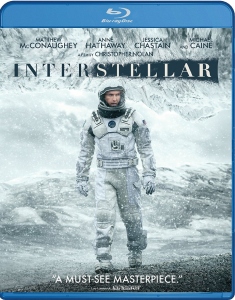“Interstellar” follows in the footsteps of “2001: A Space Odyssey” (1968) and “Contact” (1997) in the way it blends hard science and spirituality. Actually, the point of the film is almost identical to those two forbearers, penned by hard-science legends Arthur C. Clarke and Carl Sagan respectively.
As we move further along the scientific path, we may find that some things transcend science, or that answers can be found through a melding of science and spirituality, or that science proves aspects of spirituality to be accurate.
Zimmer and vigor
I’m struggling with whether to criticize “Interstellar” for my filmgoing experience. The local IMAX theater blasted the sound so loud that I could hardly think straight; I’m not sure if the film or the theater sets the volume. Regardless of that, I feel like Hans Zimmer’s score is way too heavy in the mix, as if the filmmakers didn’t trust the beauty of the images or the universal power of the father-daughter story enough and tried to hammer tears out of our skulls with blunt orchestral force.

“Interstellar” (2014)
Director: Christopher Nolan
Writer: Jonathan Nolan, Christopher Nolan
Stars: Matthew McConaughey, Anne Hathaway, Jessica Chastain
But looking beyond those flaws, it is exciting to see a modern film that views hard science as dramatic obstacles for the characters rather than something to be subverted in the scripting stage. (“Interstellar” doesn’t subvert science, but it is guilty of simplifying; more on that later.) Other than “Planet of the Apes,” I can’t think of another film that puts relativity front and center as a dramatic concern.
When farmer/engineer Cooper (Matthew McConaughey) leaves his family to pilot a secret mission for NASA through a wormhole to another galaxy that could provide new Earths for humanity, he tells his daughter Murph (Mackenzie Foy as a kid and Jessica Chastain as an adult) that when he returns to Earth, they might be the same age, due to time dilation around the wormhole. (Our Earth is essentially dying of a planet-wide Dust Bowl.)
While the Cooper-Murph relationship calls to mind “Contact” (which also starred McConaughey, coincidentally), “Interstellar” gives more nods to its older influence. The wormhole appears near Saturn, just as the monolith appeared there in the “2001” novel (although it was changed to Jupiter in the film version).
And “Interstellar’s” mobile computers are cuddlier versions of monoliths (but be careful not to get your fingers pinched when they are reconfiguring into new shapes). Instead of HAL and SAL from the “Space Odyssey” franchise, here we get TARS and CASE.
Spectacle and surprises (Spoilers)
(Since “Interstellar” is so much about spectacle and surprises, I’ll put a SPOILER WARNING here, as I embark on analyzing details of the film.)
In another dramatic use of relativity, Cooper and his colleagues (Anne Hathaway and Wes Bentley) know they must get on and off a prospective settlement planet near the wormhole very quickly lest they lose several years due to time dilation – after all, the clock is ticking for folks back on the dying Earth.

As is often the case in director Christopher Nolan’s films (see also “Inception”), the big ideas are backed by stunning visuals. The aforementioned planet is nothing but shallow water interrupted by huge waves from the tidal pull of Gargantua (the wormhole).
Another planet (filmed in Iceland) features beautiful stretches of untouched ice – there are even clouds of ice in the air! The flight through the wormhole – despite being a sci-fi cliché – is spectacular, as is Cooper’s head-spinning return trip.
Nolan nicely balances fact-based scientific wonder with moral conundrums and pontifications about humanity. It’s hard to argue with the assertion that although mankind was born on Earth, we weren’t meant to die here, but it’s a rare person who will put the future of the human race ahead of his own family.
Moral questions (Spoilers)
“Interstellar” raises the question of whether it’s morally justifiable to trick someone into doing just that, under the theory that no one would naturally have their priorities in that order.
It’s on this point that “Interstellar” shows cracks in its logic. Professor Brand (Michael Caine) believes he needs to trick the Endurance team by dangling the seemingly impossible Plan A (save the current population of Earth, and by extension, the human race) even though he really wants them to implement the more practical Plan B (seed new planets with new humans, grown in labs, in order to save the human race).
But that seems to contradict the fact that 12 brave people DID leave their loved ones behind and volunteer for missions-of-no-return when they scouted planets in the new galaxy. I like the twist that Dr. Mann (Matt Damon) couldn’t handle a lonely death on the ice planet and therefore faked scientific data so he would be rescued.
But I find it fishy that NASA sent 12 manned missions, rather than 12 unmanned probes, when it didn’t have the capability of later picking those people up.
Contrivances (Spoilers)
Indeed, several contrivances are cooked into “Interstellar”:
- How is it that NASA is well-funded (albeit secretly) and well-staffed, with equipment so cutting-edge and user-friendly that the out-of-practice Cooper is the best man to fly Endurance, yet it can’t afford to send 12 follow-up missions? As we see at the film’s end, in a matter of a half-century (judging by Murph’s aging), NASA has built a magnificent space station (complete with baseball fields and museums!) near the wormhole and is smoothly and efficiently embarking on the process of colonizing the new galaxy. NASA is fly-by-night or all-powerful depending on the needs of the script.
- While the idea of rushing on and off a planet to minimize time dilation is cool, it doesn’t make sense that a planet (and certainly not a habitable one that includes a life-giving sun) could be so close to an object that dilates time to that extreme.
- The sending and receiving of messages through the wormhole happens oh-so-conveniently. Wouldn’t there at least be some garbling of the transmission?
- At times, it feels like the characters are explaining the science to each other for the audience’s benefit, when the characters themselves should know all this stuff intimately.
Still, there aren’t a lot of films in this “spirituality of science” subgenre to begin with; “2001” is groundbreaking but unwatchably dull (I am an apologist for “2010,” though), and while I liked “Contact,” I know most people found it yawn-worthy, too.
For sheer entertainment value, “Interstellar” raises the bar, and it’s close enough on the science to at least get people talking about real science or tracking down Science Channel on their dial. And really, my above critiques are minor compared to the prospect of unlocking the scientific principles behind “Interstellar’s” ending.
Then again, the same thing could be said for “2001” and “Contact.” In all three films, the science purposely gives way to the spiritual and emotional side of the human journey.
You might want to bring earplugs to your screening, though, or wait for DVD so you can control the volume.

